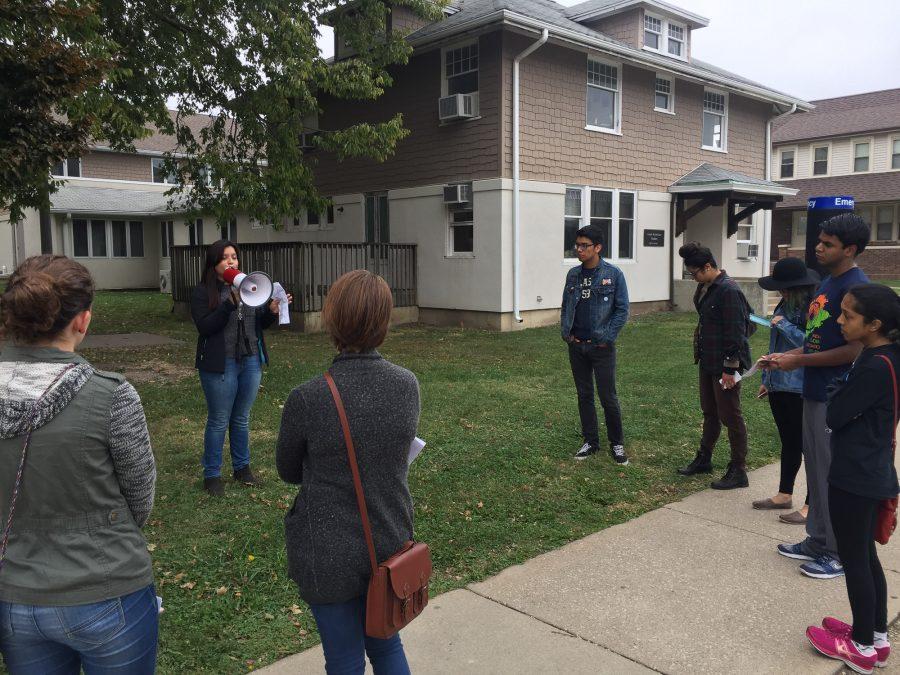Hidden History: Students celebrate activism through campus tours
Photo Courtesy of Camille Baer
Tour guides inform students about Hidden Histories on Campus.
October 17, 2016
It’s an overcast Saturday morning, and on the Main Quad side of the Henry Administration Building, three student tour guides and Associate Professor of the Department of History Kathryn Oberdeck wait for people to gather around.
People stand around and make polite small talk while waiting for anyone else to arrive. Around 11:05 a.m., the last tour guide arrives, and it seems that everyone attending the tour is there.
“Shall we begin?” says Oberdeck, checking her watch, and the guides nod in agreement.
She cracks a joke that it’s always a good sign when there are more attendees than tour guides — some laughs are passed around, and the tour finally starts.
The student tour guides are part of a “research cluster” on public history, which is funded by the Illinois Program for Research in the Humanities. The students are registered for the course called Internship in Public History. The four “hidden history” tours took place Oct. 10 and last weekend.
Get The Daily Illini in your inbox!
“I got an email by a former professor who worked here, and she basically invited all three of us to join this cluster and to do research,” said Arianna Adkins, senior in LAS and LLS.
This research cluster was established during the spring semester of 2016.
“I was asked by some of the public history interns who did the tour last year, and then they had some seniors last year who were graduating, obviously, so they asked me if I was interested in joining,” said Gabriel Perez, junior in LAS.
The research cluster was formed before the Illinois Program for Research in the Humanities decided to offer their support. Gabriela Garay, senior in LAS and LLS, said the Illinois Program for Research in the Humanities really liked what they were doing for the University and agreed with their mission of studying public history.
The tours last year combined Champaign and Urbana’s history into one tour, but this year, they were separated into their own tours.
“We felt that two distinct tours would be better than one conglomerate tour,” Perez said. “Once we found out it was going to be two different tours, everybody else decided what was important to include about Champaign specifically and Urbana specifically.”
A general consensus emerged that it’s much harder than expected to limit the amount of research discovered for a tour — especially when these students feel connected to the history that’s being discovered.
“There’s so much that we want to include, but we have to cut it off at some point. For a lot of us, the information we were looking up was personal in some ways that we were really interested and invested in finding out for our own use too,” Garay said.
When it came down to the specific kinds of information to be included on the tours, each student had their own interests that they were allowed to explore, finding ways to incorporate them into a cohesive tour. The students had to pick locations that were significant to them in some way, but it was also important that together, they made sense on a map.
“We had a lot of freedom, and opportunity, to be able to say a lot of things that we wanted to say,” Garay said.
After the first location on the tour, Perez led the way, adding a small fun fact from The Chicago Tribune about student-led activism on the Quad, where they built an entire shanty town to protest for solidarity with the anti-apartheid movement in South Africa and participated in a demonstration for the University to divest 17.7 million dollars in investments from companies who did business in South Africa.
The tour continued to the Red Herring — a vegetarian restaurant that has “a rich history of fostering student activism since the 1960s,” according to the brochure handed out at the beginning of the tour.
After the Red Herring, the tour moved on to Nevada Street, a University spot rich in culture.
“When we talk about the cultural centers, for a lot of students of color or other marginalized communities, they come in and they see these buildings but maybe they think, ‘Oh, the University put them there because they needed spaces for their students of color,’ but in reality it was all because of student activism,” said Maria Valenzuela, junior in LLS and LAS.
The tour encourages participants to look at the University differently by understanding the significance and the hard work students put toward creating more opportunities for others at the University.
“As a marginalized student on this campus, I think it’s important for us to have genealogies of our histories of the University of Illinois. Black, Latina, Asian and especially Native students have had a presence on this campus for decades, if not over a century,” Garay said. “The dominant narrative we are told is that we don’t belong here, but these ‘Hidden Histories’ of student activism, and how we’ve reclaimed spaces, is a reminder that not only we belong here but that others like us have fought hard for us to be here.







